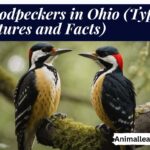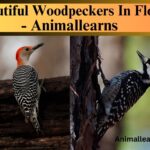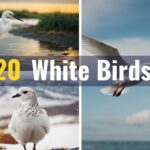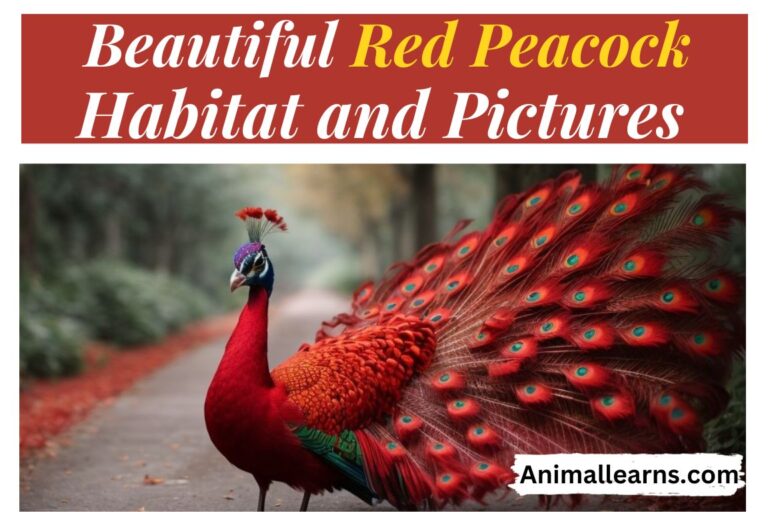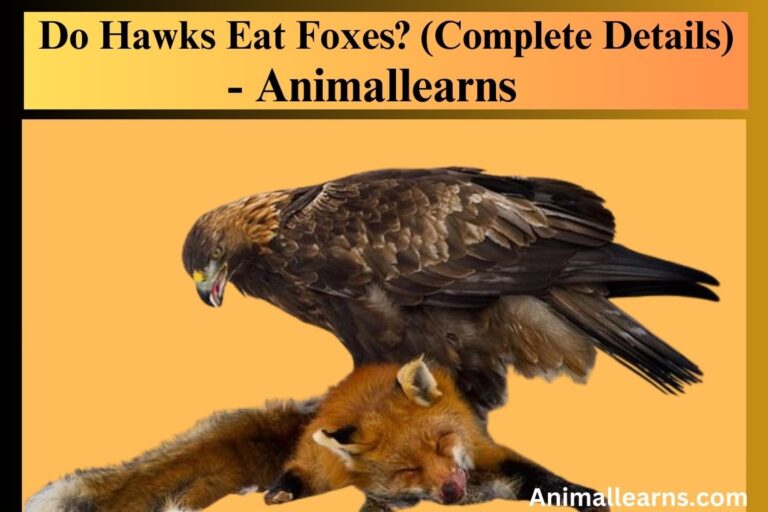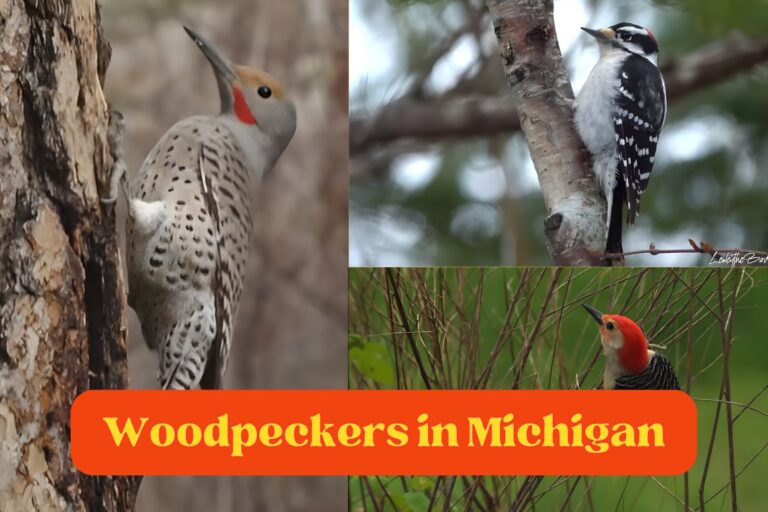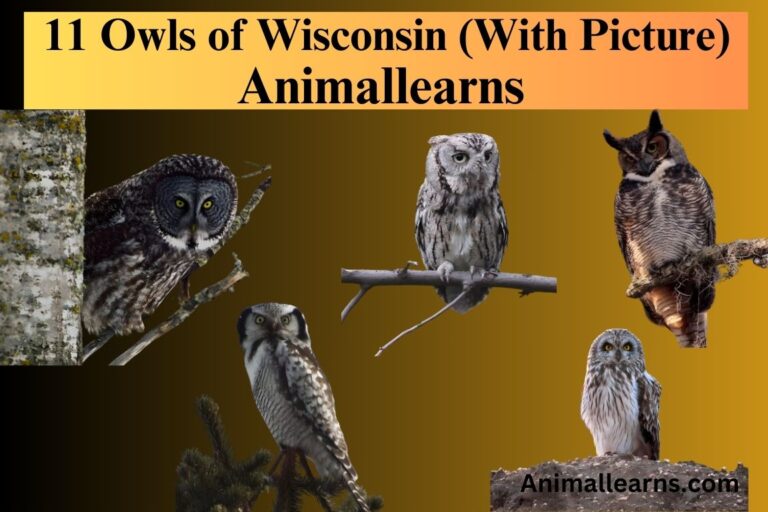Top 30 Beautiful Black And White Birds

In the avian world, black and white birds can blend seamlessly into nature’s canvas or boldly stand out against it. In addition to camouflage and confusion, these feathered creatures also use their monochromatic hues to evade predators and catch prey.
It is not surprising that North America is home to such a diverse range of birds, including charismatic chickadees, stealthy Black-crowned night herons, industrious Downy Woodpeckers, and intricately patterned Black-and-White Warblers.
During our exploration of the landscapes of gardens in the UK, we encounter striking birds such as magpies and coal tits that can be difficult to identify even to seasoned bird watchers.
People often think of pandas, zebras, and orcas when they think of black and white animals, but there are also ospreys, puffins, warblers, chickadees, and woodpeckers with this eye-catching coloration.
These black and white birds, and yellow, and purple birds make a stunning addition to nature’s grand symphony with their bold plumage patterns that make them both elusive and captivating.
Black And White Birds List
Contents
- 1 Black And White Birds List
- 1.1 Black and White Hawk Eagle
- 1.2 Pied Crow
- 1.3 Magpie
- 1.4 Lark Bunting
- 1.5 Snowy Owl
- 1.6 Black-crowned Night Heron
- 1.7 Rose Breasted Grosbeak
- 1.8 Eastern Kingbird
- 1.9 Black Guillemot
- 1.10 Black Tern
- 1.11 White-winged Dove
- 1.12 Black Skimmer
- 1.13 Black Phoebe
- 1.14 Black-capped Chickadee
- 1.15 Black-throated Sparrow
- 1.16 Black and white Warbler
- 1.17 White Breasted Nuthatch
- 1.18 Black Rail
- 1.19 Black-chinned Hummingbird
- 1.20 Black-necked Stilt
- 1.21 Black Headed Ibis
- 1.22 Penguins
- 1.23 White-tailed Kite
- 1.24 Black-billed Magpie
- 1.25 Black-legged Kittiwake
- 1.26 Black-headed Grosbeak
- 1.27 Black-capped Vireo
- 1.28 Black-capped Gnatcatcher
- 1.29 Black-tailed Gnatcatcher
- 1.30 Black Rosy-Finch
- 2 Black and White Birds Photography: Capturing Nature’s Contrast
- 3 Exploring the Diversity of Black and White Birds with Long Tails
- 4 Unraveling the Mystery of Black and White Birds: From Magpies to Puffins
- 5 FAQs
| Bird Name | Bird Name |
| Black and White Hawk Eagle | 16. Black-and-white Warbler |
| Pied Crow | 17. White-breasted Nuthatch |
| Magpie | Black Rail |
| Lark Bunting | Black-chinned Hummingbird |
| Snowy Owl | Black-necked Stilt |
| Black-crowned Night Heron | Black-Headed Ibis |
| Rose-Breasted Grosbeak | Black Vulture |
| Eastern Kingbird | White-tailed Kite |
| Black Guillemot | Black-billed Magpie |
| Black Tern | Black-legged Kittiwake |
| White-winged Dove | Black-headed Grosbeak |
| Black Skimmer | Black-capped Vireo |
| Black Phoebe | Black-capped Gnatcatcher |
| Black-capped Chickadee | Black-tailed Gnatcatcher |
| Black-throated Sparrow | Black Rosy-Finch |
Black and White Hawk Eagle
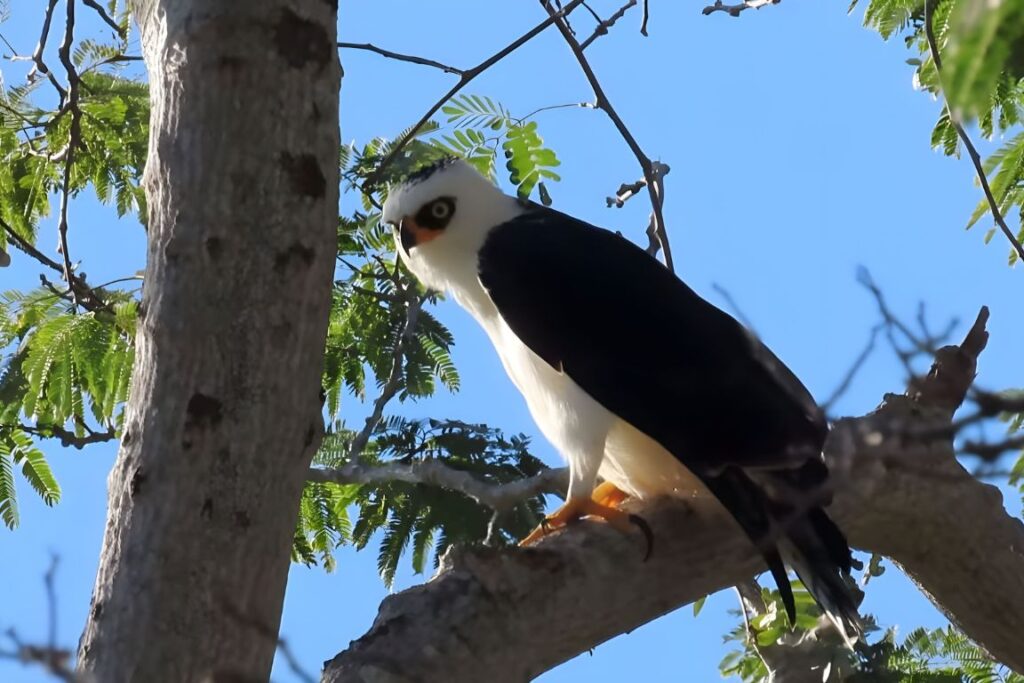
| Attribute | Value |
| Scientific Name | Spizaetus melanoleucus |
| Length (inches) | 22-27 |
| Weight (grams) | 700-1400 |
| Diet | Birds, mammals, reptiles |
| Group | Eagle |
| Flying Speed (mph) | 30-40 |
| Location | Central and South America, tropical forests |
Hawk eagles grow to be relatively small, with white heads, necks, and bodies. Black rings surround the yellow eyes of the birds. Across much of the northern half of Africa, they live in many types of lowland forests, from dense and humid to semiarid.
All types of prey, including birds, mammals, reptiles, and amphibians, are taken as prey by this species. Stick platforms are constructed in trees as nests.
Pied Crow
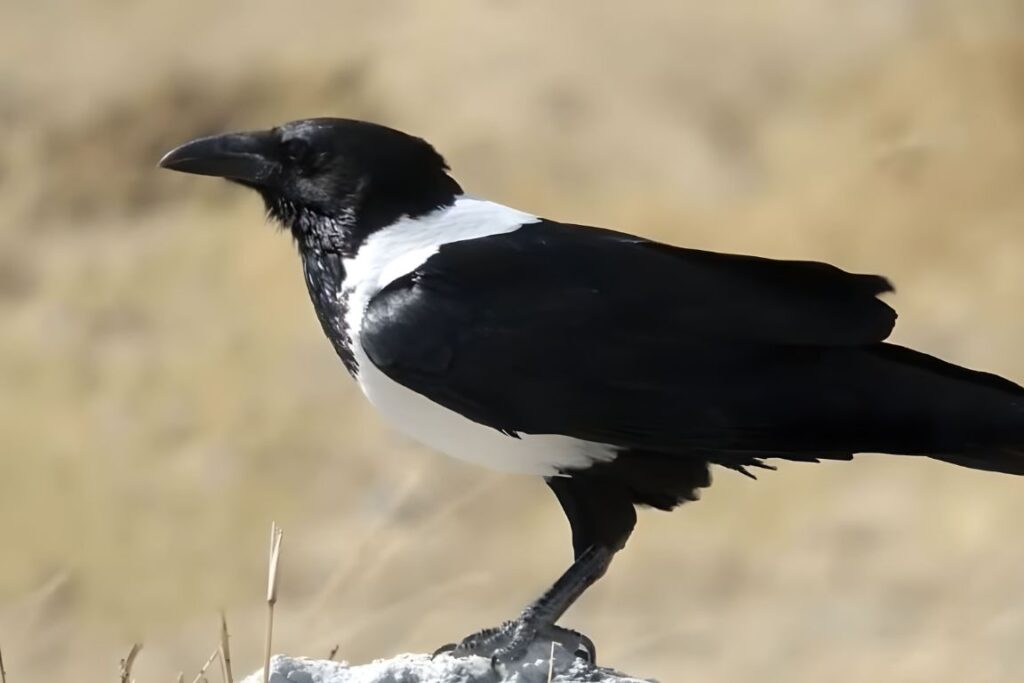
| Attribute | Value |
| Scientific Name | Corvus albus |
| Length (inches) | 18-20 |
| Weight (grams) | 380-620 |
| Diet | Omnivorous, scavenger |
| Group | Songbird |
| Flying Speed (mph) | Unknown |
| Location | Sub-Saharan Africa, open country and cities |
Sub-Saharan Africa and the Middle East are home to the striking Pied Crow (Corvus albus). Pied Crows are opportunistic omnivores with a penchant for scavenging that have predominantly black plumage with contrasting white markings.
Due to its adaptability to urban environments, it has gained a reputation for being a notable corvid species in avian research due to its widespread distribution and success.
Magpie

| Scientific Name | Pica pica |
| Length (inches) | 17-21 |
| Weight (grams) | 150-250 |
| Diet | Omnivorous, seeds, beetles, fruits |
| Group | Songbird |
| Flying Speed (mph) | 20-25 |
| Location | Worldwide, various habitats |
They are relatively large birds (belonging to the corvid family) with very long tails and heavy bills. Black-billed magpies are characterized by black-and-white bodies and iridescent wings and tails.
Throughout the Northwestern and Southwestern parts of the United States and Canada, these birds are common in towns and fields throughout the year.
Their favorite foods are fruit, grain, beetles, grasshoppers, small mammals, baby birds, and carrion. In trees, shrubs, buildings, and utility poles, their nests are made up of stick and mud domes.
Lark Bunting

| Attribute | Value |
| Scientific Name | Calamospiza melanocorys |
| Length (inches) | 5.5-7.5 |
| Weight (grams) | 25-40 |
| Diet | Seeds, insects |
| Group | Sparrow |
| Flying Speed (mph) | 25-30 |
| Location | North America, grasslands and prairies |
It is a large sparrow with a conical bill, a large body, and streaky brown feathers outside the breeding season. Male breeding pairs are black with white wing patches. In Mexico and Central America, Lark buntings live in agricultural fields and open grasslands.
Insects, spiders, grains, grass seeds, and cactus fruit are their main sources of nutrition. Cacti or shrub bases are used as nesting sites. They build loose grass cups.
Snowy Owl

| Attribute | Value |
| Scientific Name | Bubo scandiacus |
| Length (inches) | 20-28 |
| Weight (grams) | 1600-2950 |
| Diet | Mainly lemmings, small mammals |
| Group | Owl |
| Flying Speed (mph) | 50-60 |
| Location | Arctic regions, tundra |
A majestic raptor, the Snowy Owl (Bubo scandiacus) inhabits the Arctic and is known for its distinctive white plumage that makes it an excellent camouflage bird for its snowy surroundings. The Snowy Owl’s pristine white feathers serve as an adaptation to its harsh environment, unlike other birds on this list that are typically black and white.
For ecologists who study the impacts of climate change on polar fauna, these powerful hunters are emblematic of Arctic ecosystems.
Black-crowned Night Heron

| Attribute | Value |
| Scientific Name | Nycticorax nycticorax |
| Length (inches) | 23-28 |
| Weight (grams) | 625-1100 |
| Diet | Fish, small mammals, insects |
| Group | Heron |
| Flying Speed (mph) | 20-30 |
| Location | Worldwide, wetlands and coastal regions |
Light gray with white undersides and a black cap, this small heron has a thick neck, flat head, and heavy bill. A wide range of habitats and locations are found throughout North and South America, including estuaries, marshes, reservoirs, and lakes.
A wide range of aquatic insects, crustaceans, fish, amphibians, reptiles, birds, eggs, and small mammals provide food for them. Stick platforms are used as nests in trees or cattails.
Rose Breasted Grosbeak

| Attribute | Value |
| Scientific Name | Pheucticus ludovicianus |
| Length (inches) | 7-8 |
| Weight (grams) | 28-46 |
| Diet | Seeds, insects, fruits |
| Group | Finch |
| Flying Speed (mph) | 20-25 |
| Location | North America, woodlands and gardens |
It is characterized by a vibrant rosy patch on the breast that distinguishes the Rose-Breasted Grosbeak (Pheucticus ludovicianus). The songbird breeds in North America and exhibits sexual dimorphism, with males displaying striking rosy plumage.
Among birdwatchers and ornithologists studying migratory patterns and songbird behavior, the Grosbeak is well known for its melodious song and distinctive coloration.
Eastern Kingbird

| Attribute | Value |
| Scientific Name | Tyrannus tyrannus |
| Length (inches) | 7.5-9 |
| Weight (grams) | 33-55 |
| Diet | Insects |
| Group | Flycatcher |
| Flying Speed (mph) | 20-25 |
| Location | North and South America, open habitats |
Black and white flycatchers such as the Eastern Kingbird (Tyrannus tyrannus) are known for their assertive behavior and distinctive crown-shaped feathers. It is capable of catching insects mid-air, demonstrating remarkable agility and precision, and can be found all over North America.
A captivating species for behavioral ecologists and bird enthusiasts alike, it has monochromatic plumage and a feisty demeanor.
Black Guillemot
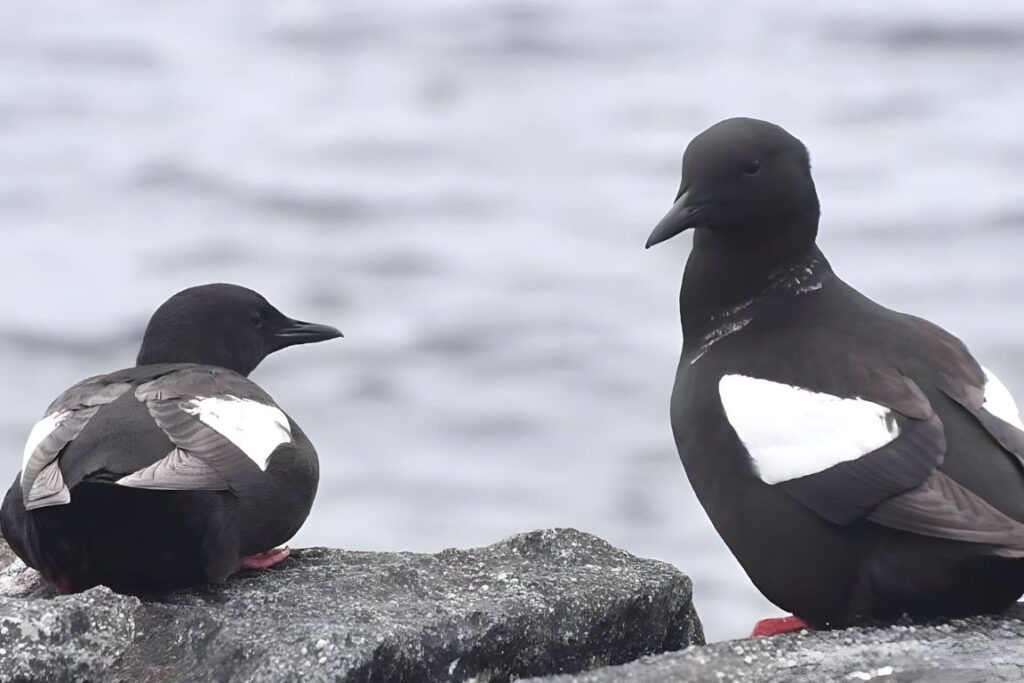
| Attribute | Value |
| Scientific Name | Cepphus grylle |
| Length (inches) | 12-14 |
| Weight (grams) | 350-600 |
| Diet | Fish, crustaceans |
| Group | Guillemot |
| Flying Speed (mph) | 30-40 |
| Location | Arctic and Subarctic regions, coastal areas |
A seabird with striking black and white coloration, the Black Guillemot (Cepphus grylle) inhabits the Arctic and subarctic regions. Its plumage changes dramatically during breeding season, with its black feathers turning white.
In addition to its bright red feet and bill, the Black Guillemot’s color change makes it an attractive subject for researchers looking at how marine birds adapt to cold conditions.
Black Tern
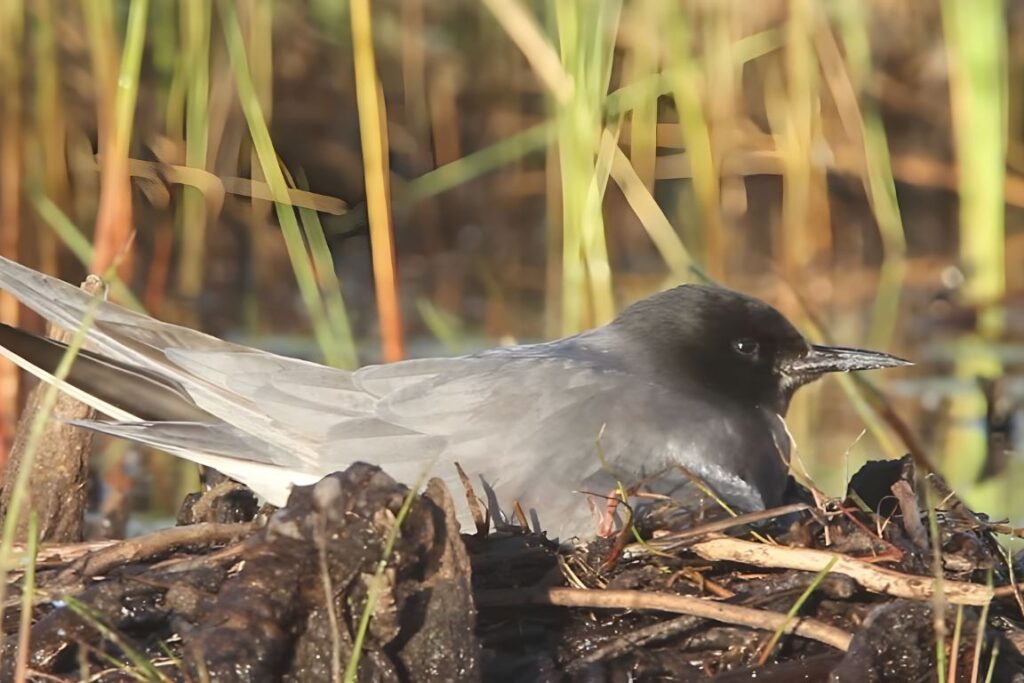
| Attribute | Value |
| Scientific Name | Chlidonias niger |
| Length (inches) | 9-10 |
| Weight (grams) | 40-90 |
| Diet | Insects, small fish |
| Group | Tern |
| Flying Speed (mph) | 20-30 |
| Location | North America, marshes and wetlands |
Known for its buoyant flight and distinctive appearance, the Black Tern (Chlidonias niger) is a sleek black and white bird. It swoosers low over water surfaces to catch insects and is found in wetlands throughout North America and Eurasia.
The striking contrast between black and white plumage and graceful flight patterns make it an intriguing subject for ornithologists who study wetlands and avian behavior.
White-winged Dove
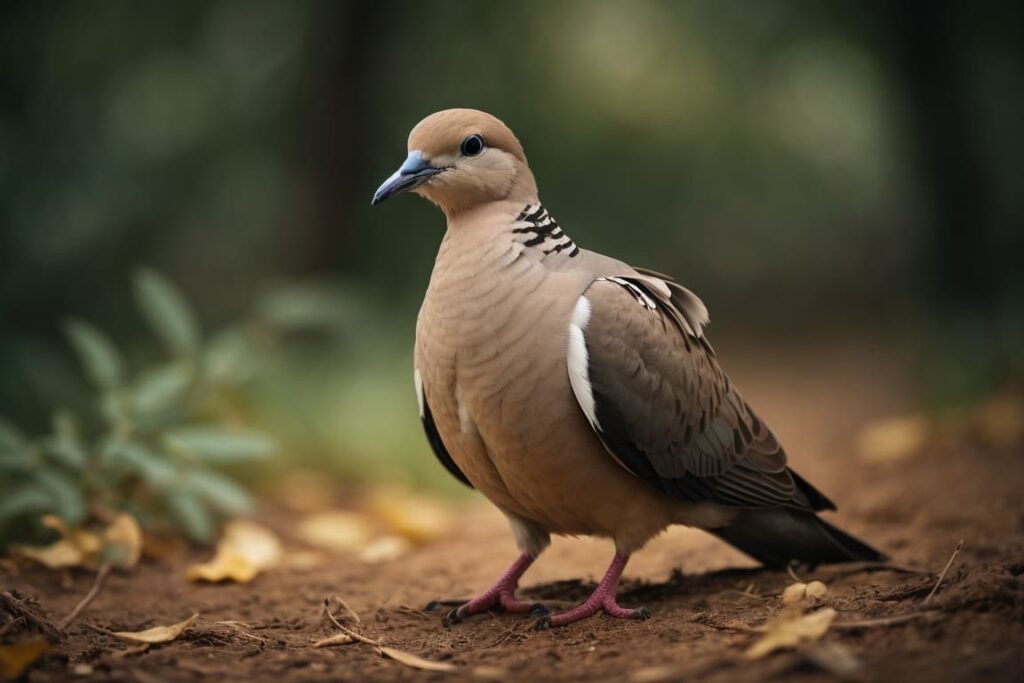
| Attribute | Value |
| Scientific Name | Zenaida asiatica |
| Length (inches) | 11-12 |
| Weight (grams) | 150-200 |
| Diet | Seeds, grains, insects |
| Group | Dove |
| Flying Speed (mph) | 20-30 |
| Location | North and Central America, arid habitats |
Known for its gentle cooing, the White-winged Dove (Zenaida asiatica) inhabits arid and urban areas in the Americas. A dove characterized by its pale plumage and distinctive white wing patches, this bird has the ability to adapt to a wide range of environments, consuming seeds and fruits as its staple diet.
Black Skimmer

| Attribute | Value |
| Scientific Name | Rynchops niger |
| Length (inches) | 17-20 |
| Weight (grams) | 210-405 |
| Diet | Fish, crustaceans |
| Group | Tern |
| Flying Speed (mph) | 20-40 |
| Location | Coastal regions, sandbars and beaches |
Black Skimmers (Rynchops niger) excel at aerial acrobatics, however. The striking bird uses its lower mandible to snatch prey, skimming through the water’s surface with its black upperparts and unique bill.
In addition to exemplifying the adaptations necessary for life on wings, the Black Skimmer lives along coastal regions.
Black Phoebe
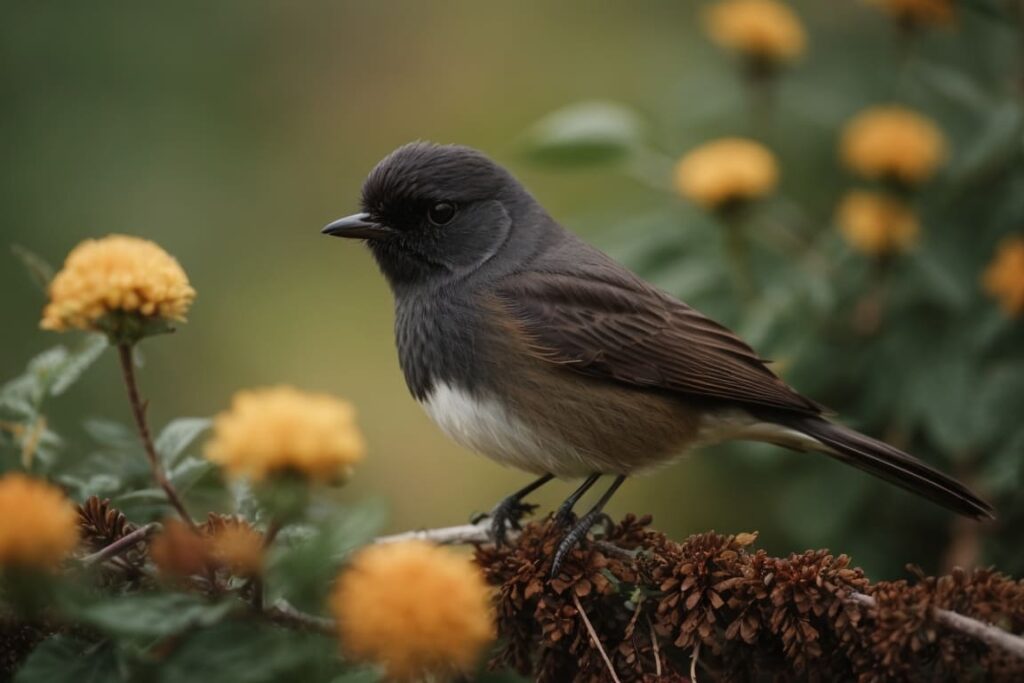
| Attribute | Value |
| Scientific Name | Sayornis nigricans |
| Length (inches) | 6-7 |
| Weight (grams) | 14-24 |
| Diet | Insects, small aquatic prey |
| Group | Flycatcher |
| Flying Speed (mph) | 20-25 |
| Location | Western North America, near water sources |
Black Phoebes (Sayornis nigricans) are charismatic flycatchers with black plumage and white underparts. Insects are captured mid-flight by this bird, and it returns to its preferred perches after capturing them.
As a distinguished presence in the ecosystems it chooses, it is known for its distinctive call and agile hunting behavior.
Black-capped Chickadee
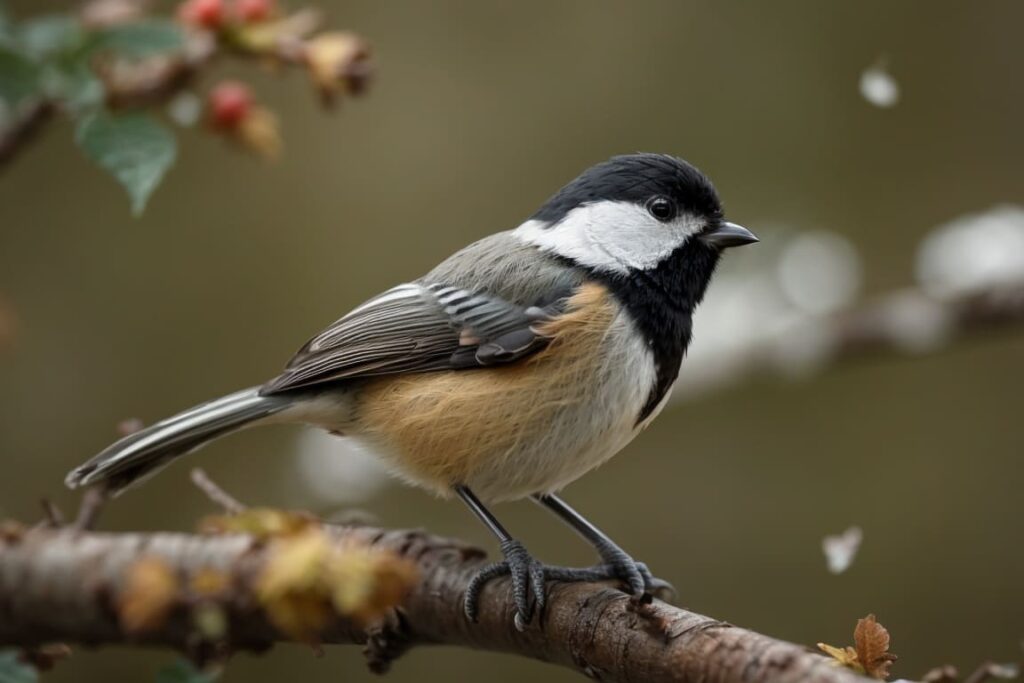
| Attribute | Value |
| Scientific Name | Poecile atricapillus |
| Length (inches) | 4.5-5.5 |
| Weight (grams) | 8-14 |
| Diet | Insects, seeds |
| Group | Chickadee |
| Flying Speed (mph) | 12-18 |
| Location | North America, deciduous and mixed forests |
The Black-capped Chickadee, a charming member of black and white birds, captivates with its distinctive black cap and bib, showcasing the enchanting contrast in its plumage.
There are a lot of gardens, parks, and woodlands in northern North America that are brightened by the charming and sociable Black-capped Chickadee.
A small, round bird with a distinctive black head and throat, white cheeks and sides, streaky grayish-blue back, and whitish underside adds to its appeal. They can be found year-round in the northern United States and Canada, from woodlots to backyards.
For shelter, they build cup-shaped moss nests in tree cavities that store food for winter survival. They eat insects, spiders, snails, caterpillars, berries, seeds, and small fruits. They also use small tree holes and wooden nest boxes for nesting, demonstrating their flexibility.
Black-throated Sparrow
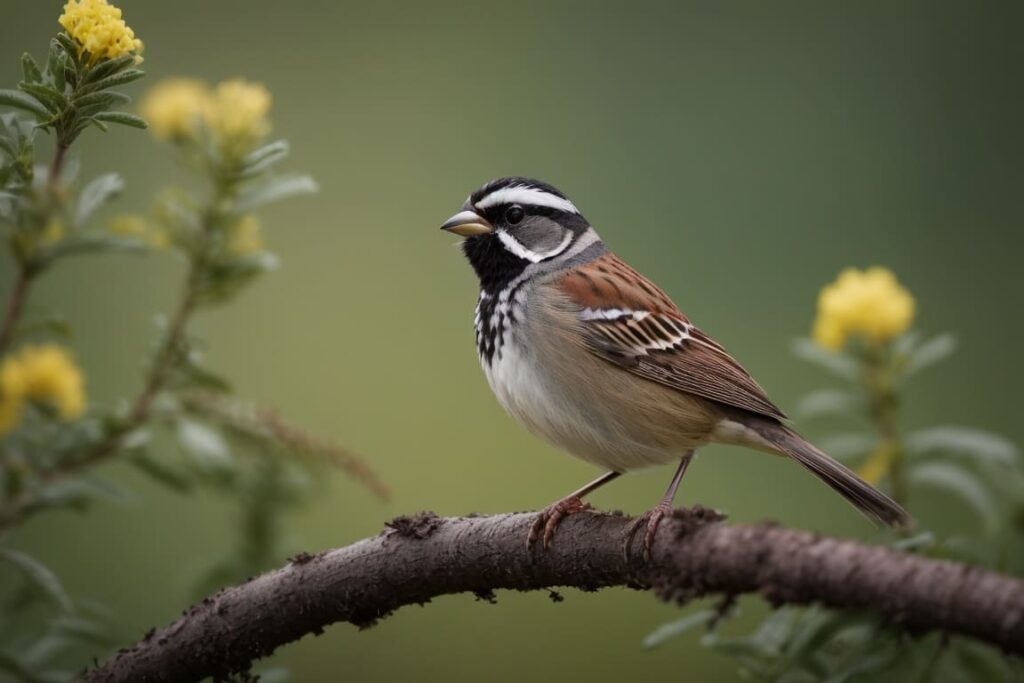
| Attribute | Value |
| Scientific Name | Amphispiza bilineata |
| Length (inches) | 5.5-6 |
| Weight (grams) | 13-20 |
| Diet | Seeds, insects |
| Group | Sparrow |
| Flying Speed (mph) | 20-25 |
| Location | Southwestern United States, arid habitats |
Black-throated Sparrows (Amphispiza bilineata) are small, subtly marked birds accustomed to desert living. While searching for seeds and insects, this sparrow adeptly navigates rocky terrain while utilizing a ground-foraging strategy, which suits its affinity for arid landscapes.
Black and white Warbler
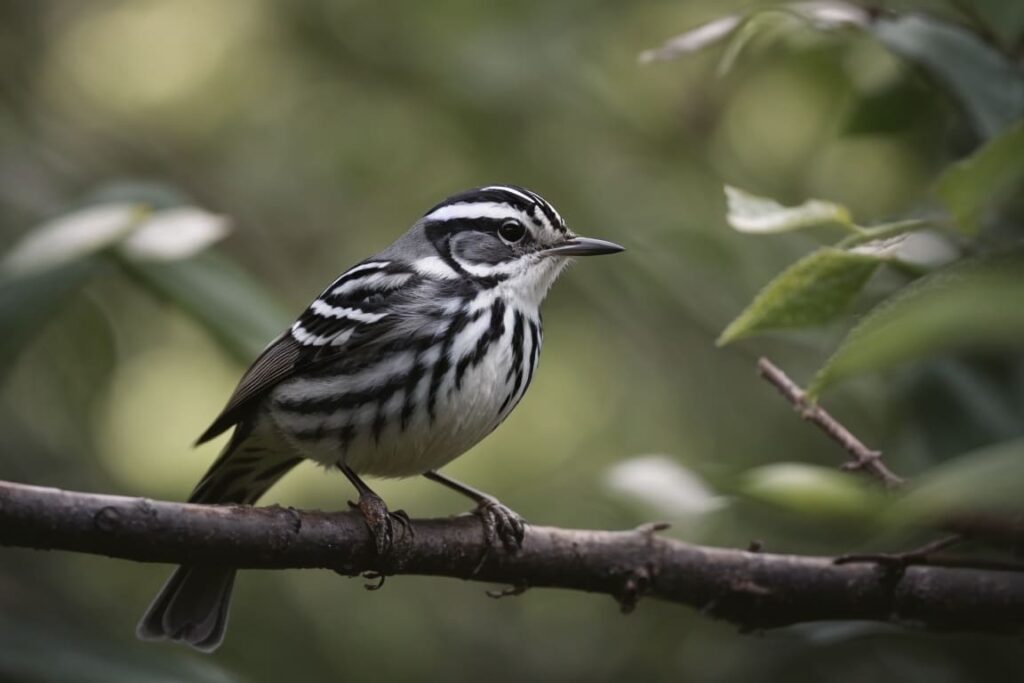
| Attribute | Value |
| Scientific Name | Mniotilta varia |
| Length (inches) | 4.5-5 |
| Weight (grams) | 7-12 |
| Diet | Insects, spiders |
| Group | Warbler |
| Flying Speed (mph) | 15-25 |
| Location | Eastern North America, deciduous forests |
In addition to their white coloration, these small birds have heavy black stripes all over their bodies. Their wings are long, their bills are long, and their tails are short.
In East Canada, the United States, Mexico, Central America, and Northern South America, they live in deciduous and mixed forests. The larvae of moths and butterflies, ants, spiders, beetles, and flies are their favorite foods. The eggs are laid in open leaf cups hidden at the base of trees, logs, and bushes.
White Breasted Nuthatch
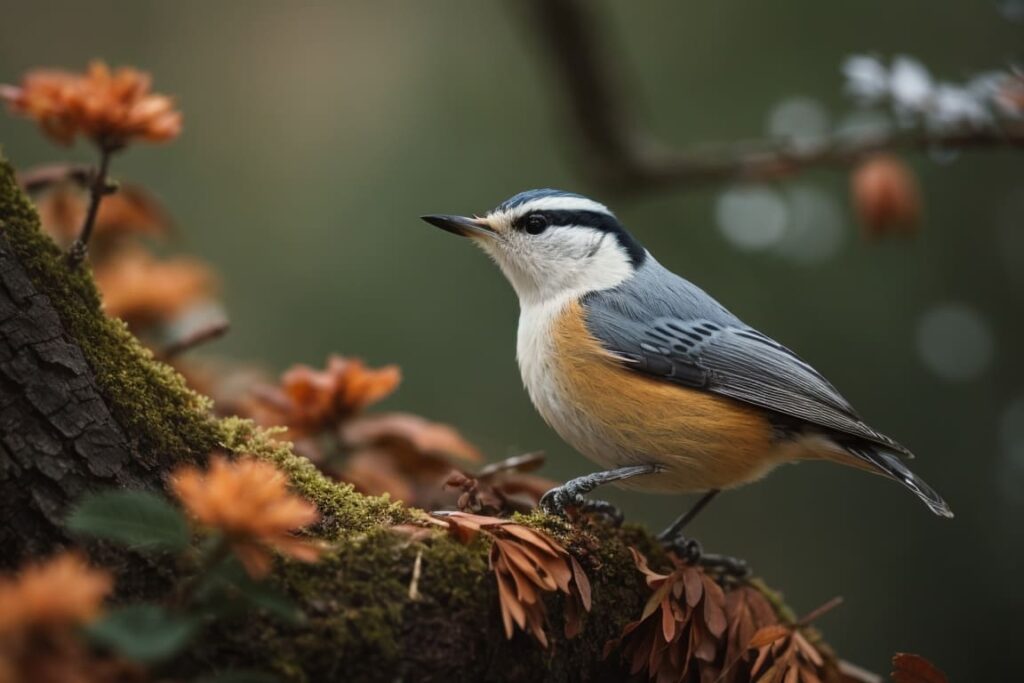
| Attribute | Value |
| Scientific Name | Sitta carolinensis |
| Length (inches) | 5.5-6 |
| Weight (grams) | 20-30 |
| Diet | Insects, seeds, nuts |
| Group | Nuthatch |
| Flying Speed (mph) | 18-25 |
| Location | North America, deciduous and mixed forests |
With its distinctive black cap and eye stripe, the White-breasted Nuthatch (Sitta carolinensis) stands out among arboreal specialists. In addition to their head-down descent along tree trunks, these small songbirds are adept at extracting insects and seeds from bark crevices, demonstrating their adaptability.
Black Rail

| Attribute | Value |
| Scientific Name | Laterallus jamaicensis |
| Length (inches) | 5.5-7 |
| Weight (grams) | 25-40 |
| Diet | Insects, small crustaceans |
| Group | Rail |
| Flying Speed (mph) | 20-30 |
| Location | Coastal marshes, wetlands |
Black Rails (Laterallus jamaicensis) are elusive birds that inhabit marshes and wetlands with their cryptic black plumage. In addition to its secretive nature and nocturnal habits, this diminutive bird emphasizes the need for conservation efforts to preserve its habitat.
Black-chinned Hummingbird

| Attribute | Value |
| Scientific Name | Archilochus alexandri |
| Length (inches) | 3.5-4 |
| Weight (grams) | 2-5 |
| Diet | Nectar, insects |
| Group | Hummingbird |
| Flying Speed (mph) | 30-45 |
| Location | Western North America, open woodlands |
With its striking black throat patch among iridescent green plumage, the Black-chinned Hummingbird (Archilochus alexandri) is an aerial maneuver master.
As a pollinator and a joy for observers in western North America, this hummingbird is attracted to nectar-rich flowers and is remarkable at flying.
Black-necked Stilt
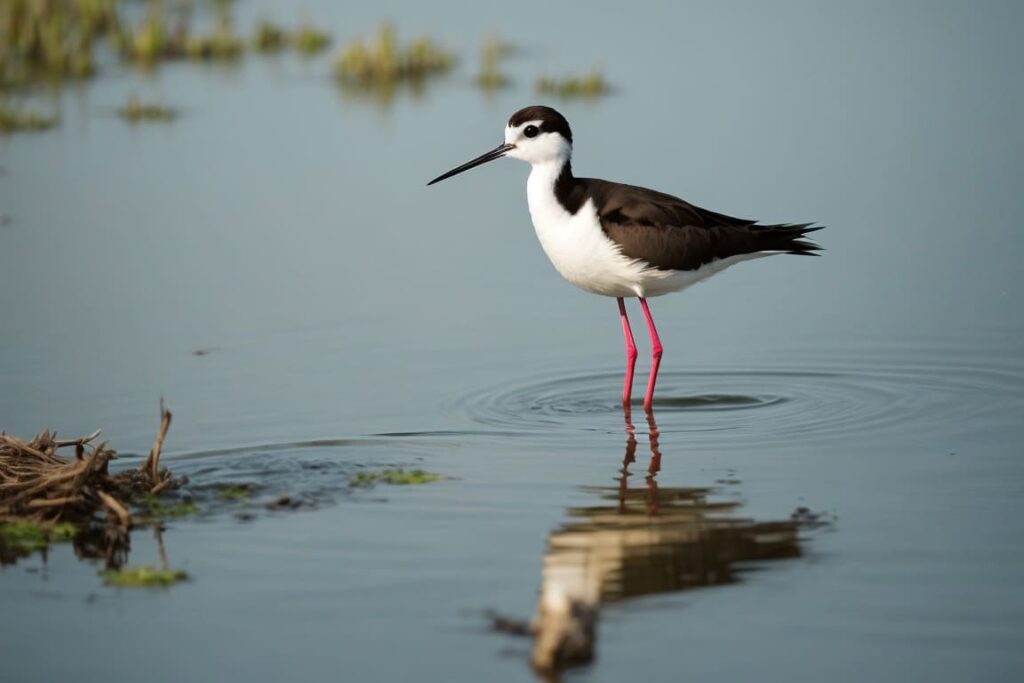
| Attribute | Value |
| Scientific Name | Himantopus mexicanus |
| Length (inches) | 14-18 |
| Weight (grams) | 140-280 |
| Diet | Insects, crustaceans |
| Group | Shorebird |
| Flying Speed (mph) | 30-40 |
| Location | Americas, shallow coastal and inland waters |
As the Black-necked Stilt (Himantopus mexicanus) wades through shallow waters on stilt-like legs, it presents striking black-and-white contrasts.
Adapted to a wide range of wetland habitats, this long-legged bird captures aquatic invertebrates with its slender bill, demonstrating how avian form and function are intertwined.
Black Headed Ibis
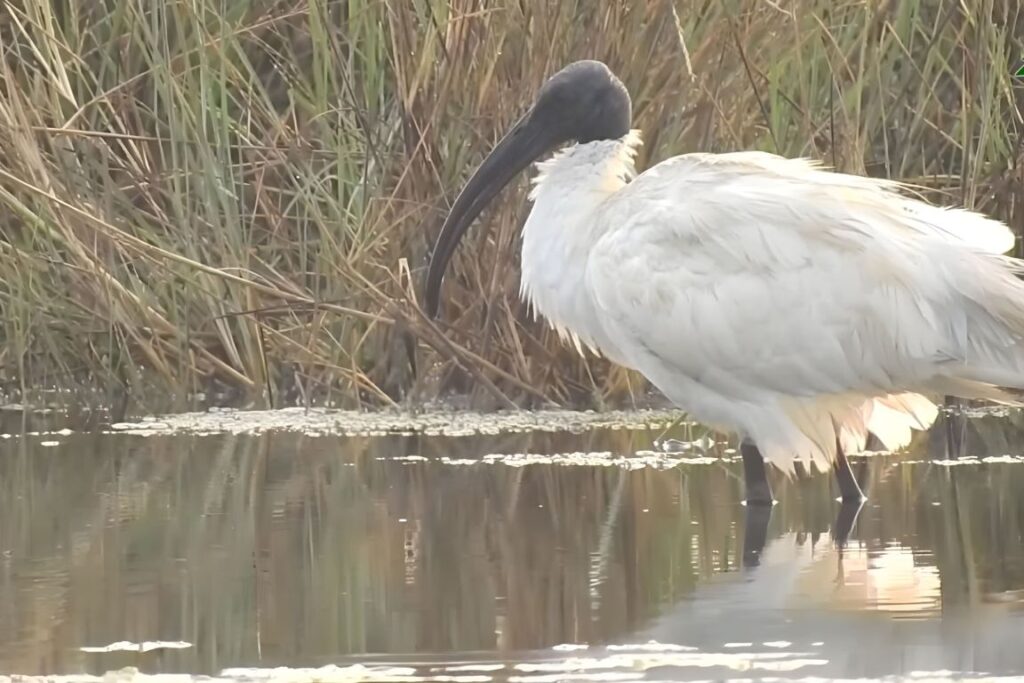
| Attribute | Value |
| Scientific Name | Threskiornis melanocephalus |
| Length (inches) | 25-28 |
| Weight (grams) | 650-950 |
| Diet | Insects, small vertebrates |
| Group | Ibis |
| Flying Speed (mph) | 30-40 |
| Location | Sub-Saharan Africa, South Asia |
As a symbol of avian elegance in wetland environments, the regal Black-Headed Ibis (Threskiornis melanocephalus) stands out with a glossy black crown.
In addition to providing a visual spectacle, this ibis plumage also serves as a functional adaptation, reflecting avian evolution and ecology.
Penguins

| Attribute | Value |
| Scientific Name | Various species belonging to the family Spheniscidae |
| Size (varies by species) | 12-45 inches (30-115 cm) |
| Weight (varies by species) | 2-100 pounds (1-45 kg) |
| Diet | Fish and other marine organisms |
| Group | Flightless bird, sea bird |
| Swimming Speed (mph) | 2-8 |
| Location | Southern Hemisphere, Antarctica, sub-Antarctic islands, South America, Africa, Australia, New Zealand |
There are a number of flightless birds that have rounded bodies and flippers. Most of them have black and white plumage, with black on top and white on the bottom. In the Southern Hemisphere, they are primarily found in oceans and along coasts, where they are aquatic birds.
Fish, krill, and squid are the primary foods they consume. An underground burrow, a scrape in the ground, or a rock crevice can be used as a nest.
White-tailed Kite

| Attribute | Value |
| Scientific Name | Elanus leucurus |
| Length (inches) | 14-17 |
| Weight (grams) | 250-375 |
| Diet | Small mammals, birds, insects |
| Group | Kite |
| Flying Speed (mph) | 25-35 |
| Location | North and South America, open habitats |
The White-tailed Kite, on the other hand, has pristine white plumage and distinctive black markings, making it an elegant raptor. Known for its hovering hunting technique, this bird of prey monitors open landscapes for small mammals and birds, adding a touch of mystique to its graceful appearance.
Black-billed Magpie
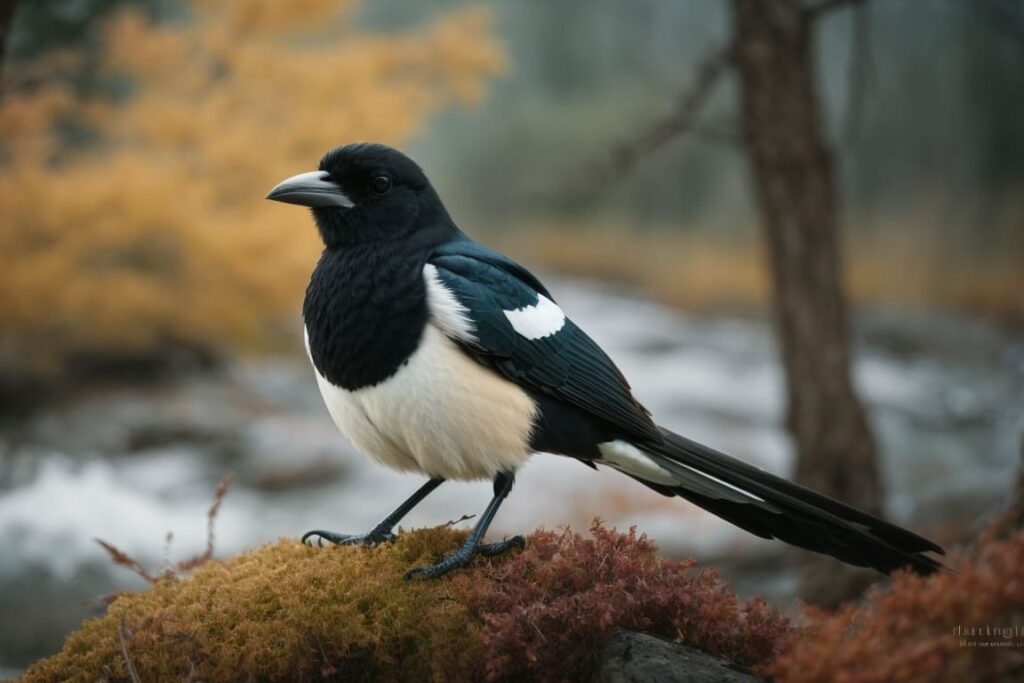
| Attribute | Value |
| Scientific Name | Pica hudsonia |
| Length (inches) | 18-24 |
| Weight (grams) | 145-210 |
| Diet | Insects, small mammals, seeds |
| Group | Magpie |
| Flying Speed (mph) | 20-25 |
| Location | North America, open woodlands and fields |
Known for its striking black and white plumage, the Black-billed Magpie (Pica hudsonia) is an intelligent corvid. With its long tail and prominent bill, this bird is an excellent problem-solver.
Its omnivorous diet and adaptability make it a success in a wide variety of habitats, including open fields and urban environments.
Black-legged Kittiwake
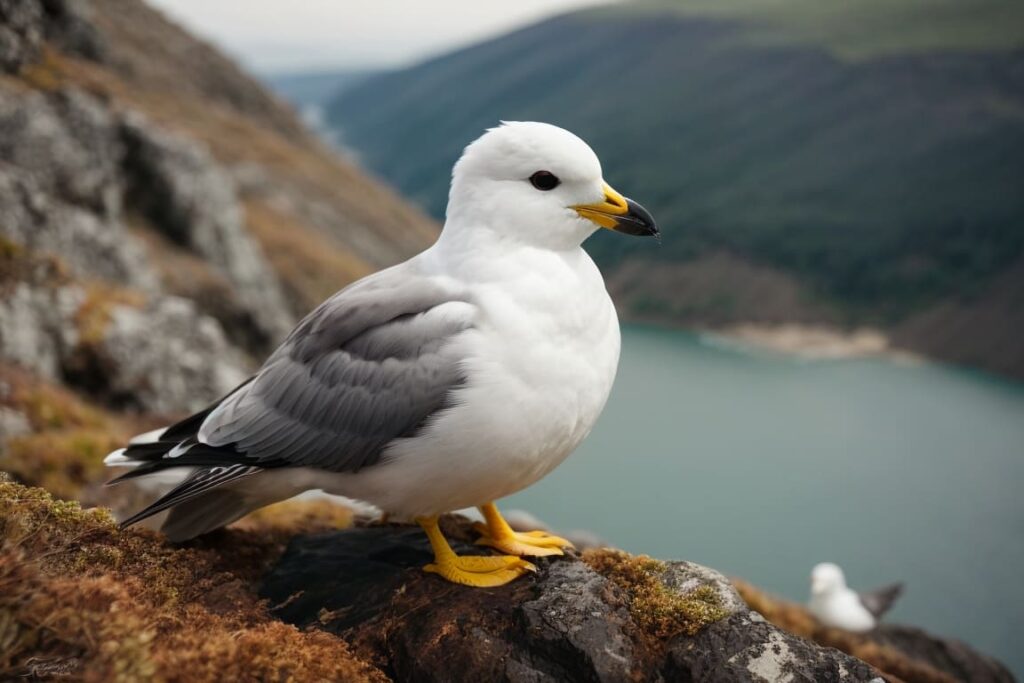
| Attribute | Value |
| Scientific Name | Rissa tridactyla |
| Length (inches) | 15-17 |
| Weight (grams) | 300-600 |
| Diet | Fish, marine invertebrates |
| Group | Gull |
| Flying Speed (mph) | 30-40 |
| Location | Arctic and Subarctic regions, coastal areas |
With black wingtips contrasting against the delicate white plumage of the Black-legged Kittiwake (Rissa tridactyla), the Black-legged Kittiwake stands out among seabirds.
Known for nesting on coastal cliffs, these birds are skilled fliers and forage for small fish and invertebrates over the ocean.
Black-headed Grosbeak
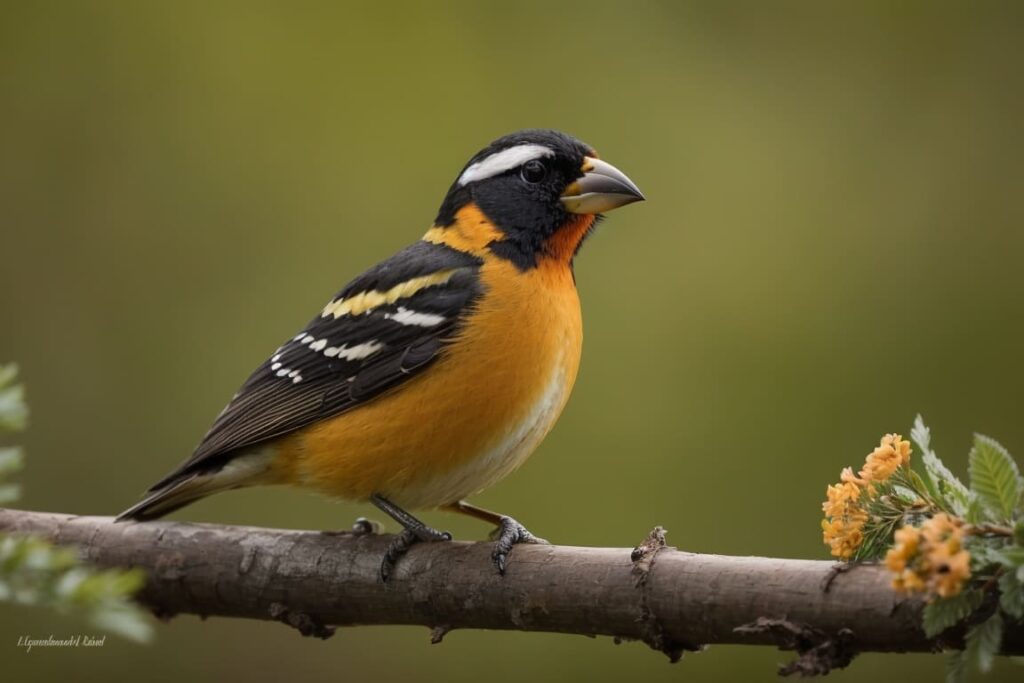
| Attribute | Value |
| Scientific Name | Pheucticus melanocephalus |
| Length (inches) | 6-8 |
| Weight (grams) | 22-47 |
| Diet | Insects, fruits, seeds |
| Group | Grosbeak |
| Flying Speed (mph) | 20-25 |
| Location | North America, woodlands and gardens |
With a striking black cap and vibrant orange and black plumage, the Black-headed Grosbeak (Pheucticus melanocephalus) is a neotropical migrant.
In addition to contributing to seed dispersal, this songbird plays a critical role in maintaining forest habitat health with its powerful beak adapted for crushing seeds.
Black-capped Vireo

| Attribute | Value |
| Scientific Name | Vireo atricapilla |
| Length (inches) | 4.5-5.5 |
| Weight (grams) | 8-15 |
| Diet | Insects, spiders, berries |
| Group | Vireo |
| Flying Speed (mph) | 15-20 |
| Location | Central and Southwestern United States, shrubby habitats |
There are conservation challenges facing the Black-capped Vireo (Vireo atricapilla), a small songbird found only on the Edwards Plateau in Texas. An icon of biodiversity preservation efforts due to its black cap and olive-green plumage, this bird’s melodious songs echo throughout oak and juniper woodlands.
Black-capped Gnatcatcher

| Attribute | Value |
| Scientific Name | Polioptila nigriceps |
| Length (inches) | 4.5-5.5 |
| Weight (grams) | 5-7 |
| Diet | Insects, spiders |
| Group | Gnatcatcher |
| Flying Speed (mph) | 15-20 |
| Location | Mexico, arid scrublands and woodlands |
Small, active insectivores with sleek black caps, the Black-capped Gnatcatcher (Polioptila nigriceps) and the Black-tailed Gnatcatcher (Polioptila melanura) live in arid landscapes of the American Southwest. As well as their constant movement, desert ecosystems are delicately balanced because of their insect-catching abilities.
Black-tailed Gnatcatcher
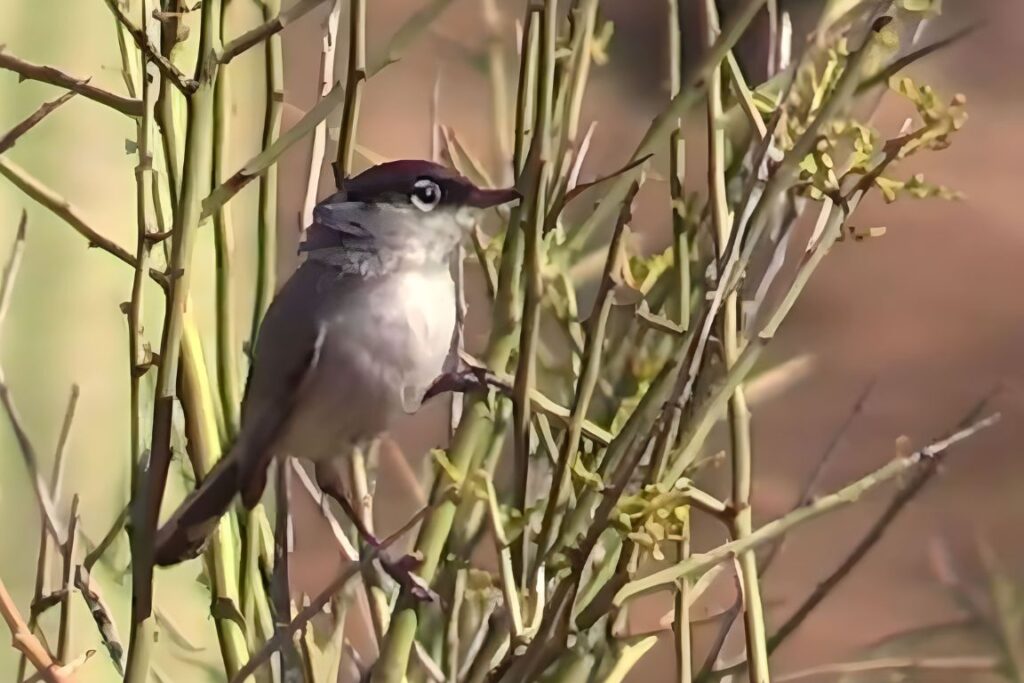
| Attribute | Value |
| Scientific Name | Polioptila melanura |
| Length (inches) | 4.5-5.5 |
| Weight (grams) | 5-7 |
| Diet | Insects, spiders |
| Group | Gnatcatcher |
| Flying Speed (mph) | 15-20 |
| Location | Southwestern North America and northern Mexico, arid habitats |
Small passerine birds, the Black-tailed Gnatcatcher, scientifically known as Polioptila melanura, are noted for their black and white plumage. This species thrives in desert scrublands and arid woodlands in southwestern North America and northern Mexico.
Known for its long tail and slender build, the bird is agile at finding insects and spiders in foliage, using its slender bill. When males engage in courtship displays during the breeding season, their vocalizations, characterized by high-pitched calls, are an important feature.
In addition to its aesthetic appeal, the Black-tailed Gnatcatcher also contributes to the balance of insect populations in its arid habitat by acting as a natural pest controller.
Black Rosy-Finch

| Attribute | Value |
| Scientific Name | Leucosticte atrata |
| Length (inches) | 6-7 |
| Weight (grams) | 16-30 |
| Diet | Seeds, insects |
| Group | Finch |
| Flying Speed (mph) | 20-25 |
| Location | Western North America, alpine and subalpine habitats |
Lastly, we explore the Black Rosy-Finch (Leucosticte atrata), which lives in alpine environments at high altitudes. This finch thrives in harsh mountainous conditions due to its dark plumage, which provides insulation against the cold. Avian life in extreme environments is shown to be adaptable and resilient.
Black and White Birds Photography: Capturing Nature’s Contrast
In the realm of wildlife photography, the allure of black and white birds is undeniable. Their striking contrast against various backdrops creates captivating visuals. Professional photographers and bird enthusiasts alike strive to capture these monochromatic marvels through black and white birds photos.
From the majestic wingspan of large black and white birds to the delicate features of small species, each photograph tells a unique story of avian elegance.
Exploring the Diversity of Black and White Birds with Long Tails
Among the enchanting array of black and white birds, those with long tails stand out as particularly fascinating. This category encompasses a variety of species, each distinguished by its own unique characteristics.
Whether soaring through the skies or perched on a branch, black and white birds with long tails showcase a remarkable blend of grace and agility. Exploring the diverse habitats of Colorado, Australia, Montana, and beyond reveals a rich tapestry of these avian wonders.
Unraveling the Mystery of Black and White Birds: From Magpies to Puffins
Delving into the world of black and white birds, one encounters a spectrum of species, from the iconic magpie to the charming puffin. The black-and-white bird’s crossword clue becomes a puzzle of nature’s design.
The mysterious allure of these creatures extends to regions worldwide, including Colorado, Australia, and England. From the bold contrast of black and white spotted birds to the elegance of white birds with black-tipped wings and tails, the avian kingdom’s diversity unfolds.
Observing the behavior and features of these birds in their natural habitats, one can’t help but appreciate the intricate beauty of the black and white bird kingdom.
FAQs
Are all black and white birds the same species?
No, black and white plumage is a common coloration found in various bird species across different families and habitats.
Why do some birds have black-and-white markings?
Black and white markings in birds serve multiple purposes, including camouflage, communication, and mate attraction.
Is the Black-tailed Gnatcatcher found only in North America?
Yes, the Black-tailed Gnatcatcher is primarily found in the arid regions of southwestern North America and northern Mexico.
What is the significance of the white eye-ring in black and white birds?
The white eye ring in many black and white birds, including the Black-tailed Gnatcatcher, is a distinctive feature that enhances their overall appearance and aids in identification.
Do black and white birds have specific roles in their ecosystems?
Yes, black and white birds often play crucial ecological roles, such as controlling insect populations and contributing to the balance of their respective ecosystems.


